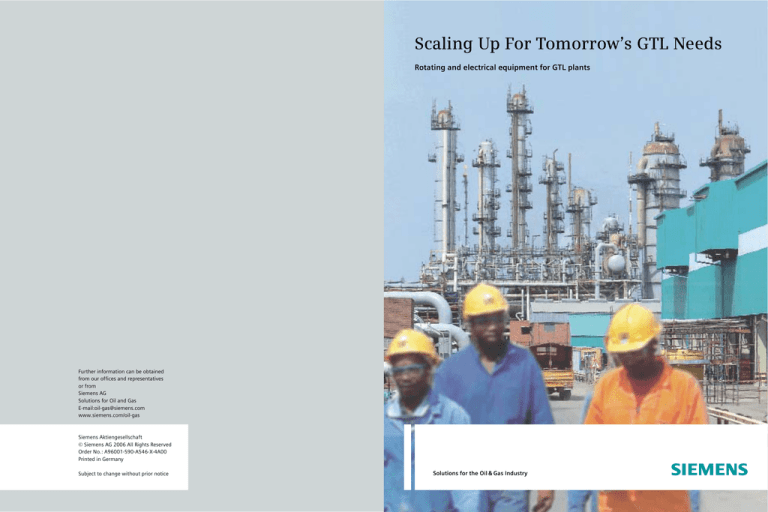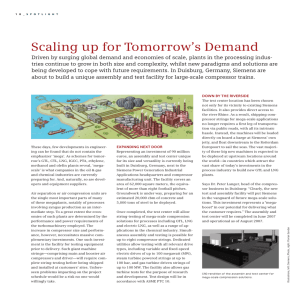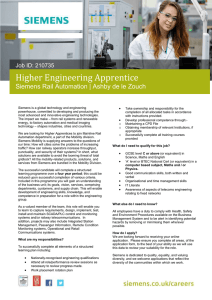
Scaling Up For Tomorrow’s GTL Needs
Rotating and electrical equipment for GTL plants
Further information can be obtained
from our offices and representatives
or from
Siemens AG
Solutions for Oil and Gas
E-mail:oil-gas@siemens.com
www.siemens.com/oil-gas
Siemens Aktiengesellschaft
© Siemens AG 2006 All Rights Reserved
Order No.: A96001-S90-A546-X-4A00
Printed in Germany
Subject to change without prior notice
Solutions for the Oil & Gas Industry
s
Realizing Stranded Value
Gas-to-liquids (GTL) technology has matured to become an economically robust and environmentally beneficial way of monetizing stranded gas reserves at the wellhead. Rising crude oil prices
as well as tightening environmental specifications for sulfur and aromatics in diesel fuel already
suggest profitable operation of GTL plants with today’s 34,000 barrels per day capacity. The
envisaged 70,000+ barrels per day of next-generation plants, however, will mean a substantial
improvement in economies of scale and, in turn, a reduction of CAPEX. In addition, optimizing
plant efficiency and availability will improve economics still further.
Enter Siemens. With high-power, high-volume compressor trains at the heart of the conversion
process, Siemens is not only a prime supplier to many current GTL projects around the world,
but is already capable of providing new machines for next-generation GTL plants. What’s more,
with power generation and distribution, water management, automation and control, industrial
IT and life-cycle services all from a single source, Siemens provides a host of solutions helping
to integrate utilities, run plants at optimal levels of efficiency and ensure maximum availability.
Innovative design, excellence in engineering, maximum lifetime value as well as ultimate compliance with health, safety, environmental and industry standards are common denominators
for all components, products, systems and services in the Siemens GTL portfolio. Combining
our competence and strengths, we can together achieve a winning performance and realize
stranded value.
Compression
A portfolio of field-proven compressors, gas and steam turbines, electric
drives and motors and their associated control systems including instrumentation for virtually all production, transport and process applications
in the oil and gas industry.
Power Generation and Distribution
Comprehensive power solutions, including planning, finance, engineering and optimization of power grids, gas and steam turbine-based power
plants, transformers, high, medium and low voltage distribution switchgear, substation automation, energy management, network consulting.
Water Management
A complete range of solutions including water treatment for use as boiler
feed water, utility water and cooling tower make-up; wastewater treatment including oil/water separation, biological treatment, membrane
treatment, chemical feed equipment; wastewater recycle/reuse systems.
Automation and Control
A unique array of automation and control products, systems and solutions for field, production and management levels. Designed to achieve
maximum productivity while realizing substantial cost savings.
Industrial IT
Enterprise intelligence solutions for safe and reliable operation, planning
and scheduling. Real-time operational intelligence; process modeling,
simulation and optimization; asset management.
Life-Cycle Services
A portfolio of life-cycle services, including feasibility studies, financial
engineering, design and network studies as well as all levels of preventive and corrective maintenance, performance enhancement programs,
service level agreements and training.
02
03
Air Separation, Air Compression
Determining the achievable economies of scale, air separation or air
compression are the single most important parts of any GTL plant. It is
here where the world’s largest compressors are employed. Depending
on the applied process, they feed massive volumes of air either directly
to the gas reforming stage, or to a cryogenic separation process, which
provides oxygen for the conversion of natural gas into syngas.
Siemens’ latest very-high-volume STC-SR main air compressor represents
a significant step towards the economies of scale required from air
separation plants for tomorrow’s GTL schemes. Delivering an amazing
700,000 cubic meters of air per hour, it effectively surpasses first-generation machines while retaining maximum long-term reliability.
Next-generation GTL plants, however, will employ even more powerful
compression solutions. In order to keep the required number of compressor trains within reasonable limits, future main air compressors will
have to achieve a volume flow of 900,000+ cubic meters per hour —
corresponding to an air separation unit output of 5,000+ tonnes per day
of oxygen. At Siemens, these compressors are part of a continuous
development program designed to meet the growing demand of megascale applications. Moreover, before being shipped and installed at customers’ sites, even the largest of these compressor trains — encompassing main and booster air compressor, and a double-ended condensing steam turbine — will have passed string-testing at Siemens’
unique large-scale compressor test bed.
Compression
Very-high-volume main air compressor • Booster air compressor
Drives
Electric motors • Steam turbines • Gas turbines
Proving technical feasibility and the economies of scale required from commercially
viable GTL/CTL front-end technology, this electric-motor driven compressor delivers
approx. 700,000 cbm/h of air to the air separation unit of SASOL’s Secunda CTL plant
near Johannesburg, South Africa, the largest of its kind worldwide. Siemens scope of
supply: STC-SR very-high-volume main air compressor and STC-GV integrally geared
booster air compressor, both driven by electric motors; process control system including distributed redundant SCADA system; integrated leak detection and batch tracking; integration of various subsystems; fiscal metering systems; automation of pump
stations with fault-tolerant programmable logic controllers (PLC); pump surge protection; system integration.
Siemens has been contracted to supply a large-scale compression solution for an air
separation plant in the Gulf region. At the heart of the solution will be a 700,000cbm/h main air compressor (STC-SR) and an integrally geared booster air compressor
(STC-GV), both powered by a double-ended 81-megawatt (MW) steam turbine — all
designed, manufactured and installed by Siemens. Scheduled for start-up in the
fourth quarter of 2007, the unit will be the most powerful of its kind in the Middle
East and range among the largest worldwide, supplying some 100,000 cbm/h of oxygen to a petrochemical refining process.
A unique test-bed facility in Duisburg, Germany, puts Siemens in the vanguard of
future mega-scale solutions development. Operational as of 2007, it will allow full
string-testing of even the largest compression solutions for GTL plants, ensuring
uncompromising reliability of compressor trains before being shipped.
04
05
Refining
From natural gas reforming, Fischer-Tropsch synthesis and hydrogen
production to product upgrading, the refining systems within a GTL
plant involve a number of diverse processes and applications. Siemens
offers dedicated product and solution portfolios for all of these.
Siemens‘ refinery compression solutions are available with a wide range
of specifications to match process needs throughout the refining stages.
They are designed in accordance with API 617 and complement ultimate reliability with economical operation. In addition, customdesigned machines are engineered to meet specific customer requirements.
Providing the vital link between the plant’s process and business levels,
Siemens’ field-proven Totally Integrated Automation (TIA) solutions
ensure manageability of even the most complex schemes. Moreover,
sophisticated process instrumentation and analytics help to hold
process conditions, HSE-relevant values and product characteristics
within tight specifications.
Compression
[by application] Natural gas booster • Syngas booster • Recycle gas
• Syngas • Propane • Recycle gas • Regeneration gas • Recontacting
Drives
Electric motors • Variable speed drive systems (VSDS) • Condensing
steam turbine • Backpressure steam turbine
Process Instrumentation & Analytics
A comprehensive process instrumentation and gas analytics portfolio
designed to provide process-relevant data directly from the heart of the
plant, enabling the process control system to run the facility at optimum productivity and efficiency.
Automation
Completely integrated distributed control system (DCS) including associated process instrumentation for the complete refining and associated
downstream processes • Advanced process control solutions for optimized process control • Integrated data visualization software enabling
informed decisions regarding utilization of facilities and their operating
efficiency • Energy management and control system (EMCS)
Tank Farm and Terminal Management
Automation and safety systems • Automated loading process • Tank
gauging • Distribution planning • Batch management • Product reconciliation and inventory management • Blending and re-branding facilities • Business system integration
Leuna 2000, Europe’s largest refinery located in Eastern Germany, relies on Siemens
compressor trains. Siemens scope of supply: six integrally geared compressors (STCGV); two vertically split single shaft compressors (STC-SV); one horizontally split single shaft compressor (STC-SH); one single shaft axial compressor (STC-SX); 110 kV
gas-insulated switchgear; power transformers; medium-voltage switchgear; integrated local control panels for the high voltage switchgear with integrated field level
automation including substation control and protection systems as well as the redundant battery system. Photo courtesy of InfraLeuna Infrastruktur & Service GmbH.
At their Port Arthur, Texas/USA mega olefin plant, BASF FINA Petrochemicals Limited
Partnership operates one of the world’s largest naphta steamcrackers. Siemens scope
of supply: five STC-SH horizontally split single shaft compressors (one cracked gas
compressor train with three casings, one propylene compressor, one compressor for
ethylene), all powered by Siemens SST-600 steam turbines; two STC-SV vertically split
single shaft compressors (one methane compressor, one hydrogen recycle gas compressor), driven by Siemens e-motors. Photo courtesy of BASF.
In Point Lisas, Trinidad, Atlas Methanol Company Ltd of Trinidad and Tobago runs the
world’s largest methanol plant in operation. This single-train plant produces 5,000
tons per day of methanol. Siemens scope of supply: two vertically split single shaft
compressors; one STC-SV synthesis gas compressor; one STC-SV natural gas compressor; SST-600 steam turbines. Photo courtesy of Lurgi.
Due to its extensive compressor train expertise with large olefin plants, Siemens
was selected to supply various compressor trains for an ethylene plant in the Persian
Gulf with an annual production capacity of 1,100,000 tons of ethylene. Siemens
scope of supply: cracked gas train featuring two large single shaft compressors
with horizontally split casing (STC-SH), and one high-pressure, barrel-type compressor (STC-SV), driven by a Siemens extraction condensing steam turbine (SST600); ethylene refrigeration train (STC-SH) and propylene refrigeration train (STCSH), both driven by Siemens steam turbines.
Helping Saudi Aramco integrate 19 sites in the eastern, western and central regions
of Saudi Arabia, Siemens’ tank farm automation system reduces both operating costs
and truck movements while providing accountability and traceability for transactions
and inventory tracking. Siemens scope of supply: system integration; terminal management; process automation; safety systems; preset controllers; building equipment;
intercom systems; data communication infrastructure; uninterruptible power supply.
06
07
Utilities
Providing hydrogen, heat recovery, boiler feed water, steam, water
treatment and balance of plant, a GTL plant’s utilities interface with virtually all stages of the process and auxiliaries. Utilities are of particular
concern with regard to the internal energy integration of a plant, for
instance when matching the large amounts of heat energy available
from the syngas and FT process stages with the plant’s power demand
in order to reduce operational expenditure (OPEX) through an overall
optimization of energy efficiency.
Another challenge is the plant’s effluent treatment and water management. Solutions have to meet stringent specifications while being
robust with regard to production swings — a factor of growing concern
with increasing plant size and output.
For over 70 years, Siemens has been providing water and wastewater
treatment solutions to the petroleum industry and has developed/introduced many standard technologies used in the industry today.
Process Power Generation and Distribution
Steam turbine gensets • Gas turbine gensets • Oil filled and cast resin
type transformers • 11 kV/6.6 kV switchgear and equipment • 33 kV and
132 kV switchgear (Air and SF6 insulated), Electrical network monitoring and control system (ENMC) • Full-scope power generation islands,
see page 10
Water and Effluent Treatment
Oil/water separation technologies • Biological treatment technologies •
Clarifiers • Filters • Membrane systems • Sludge management systems
• Chemical feed equipment • Demineralization equipment • Other
types of wastewater treatment technologies, including complete wastewater re-use systems • Bench scale and field pilot studies, ensuring
proper operation of full scale treatment systems
Recovering waste heat at a Shell Fluid Catalytic Cracking (FCC) plant, this doubleended steam turbine drives a power generator and an air compressor, greatly
improving energy efficiency. Siemens scope of supply: double-ended SST-600
steam turbine; power generator, air compressor.
What’s more, Siemens offers heat recovery and process power generation solutions scalable for optimum plant efficiency and cost effectiveness, as well as advanced process control solutions that help monitor,
evaluate and optimize operating efficiencies at all stages and processes
of the plant.
ORYX GTL Limited, Ras Laffan Industrial City, Qatar. Siemens scope of supply: two separate water treatment systems for water re-use. Wastewater treatment system including CPI separators, aeration system equipment, secondary clarifiers, dissolved air
flotation separators, traveling bridge filters, pumping systems and gravity belt thickening equipment; follow-on sanitary wastewater biological treatment package plant
including overall plant design, lift station pumps and controls, a rotating biological
contactor (RBC) with supplemental aeration, gravity clarification equipment and skidmounted chlorination and de-chlorination equipment.
Calcasieu Refining in Lake Charles, Louisiana, USA, selected Siemens to design and
supply a complete wastewater treatment plant and a follow-up upgrade to treat
the increased wastewater flow associated with major process expansions over the
following years. Saving cost and time, the single-source vendor approach proved
to be mutually beneficial. Siemens scope of supply: full-range design and installation of an entire water treatment plant, including oil/water separation, aeration and
clarification, sludge handling, VOC control equipment; support; service.
08
09
Power Generation Island
From the very beginnings of the company’s operations, power generation has been a core competence at Siemens. Today, Siemens offers
turnkey power plants and industrial power solutions for just about any
size and type of application, including typical power islands for GTL
plants. Tailored to make maximum use of process-specific low-caloric
tail gas and waste heat, advanced power technologies from Siemens
can enhance total plant efficiency significantly.
Procuring the power solution from a single source offers a number of
benefits for end-customers and EPCs alike. A single point of contact
means a significant reduction of interfaces, simplifying project management and communications. Moreover, engineering time as well as
erection and commissioning costs are reduced through harmonized
equipment and handling.
As a result, bundling of electricity production, transmission and distribution within a GTL plant is an efficient means to reduce complexity
and risk, while meeting tight schedules. At the same time, overall plant
reliability and availability are improved.
Power Generation
Gas and steam turbines including generators and auxiliaries • Heat
recovery steam generators • Water steam cycle solutions • Electrical
and controls for supplied equipment • Cranes and heat, ventilation and
air conditioning (HVAC) for turbine building • Cooling water systems
Power Transmission and Distribution
Whole range of power transmission and distribution systems, including
network planning and consulting services; high, medium and low voltage switchgear (Air and SF6 insulated); high current switchgear; power,
distribution and special transformers; substation protection and
automation systems; energy management; auxiliaries; all services for
substations
This Siemens cogeneration/combined cycle power plant provides 90% of the electrical power and 75% of the process steam for the BP Bulwer Island refinery facility
near Brisbane. In normal operation the plant is run in parallel with the grid, allowing export of any surplus power during times of low production. In the event of
a loss of power from the grid, the plant is able to disconnect and operate in island
mode and allow the refinery to continue operations. Siemens scope of supply: complete CHP plant, including two SGT-400 gas turbines.
Four of these Siemens SST-600 steam turbines provide a total of 240 MW of power
for the vast Nanhai petrochemicals complex at Daya Bay in southern China, operated by Shell Nanhai BV and its joint venture partner CNOOC Petrochemicals
Investment Limited. Siemens scope of supply: four 60 MW SST-600 steam turbinedriven gensets.
Superior performance characteristics and speed of delivery were among the key
reasons to select Siemens for supplying a 3 x 35 MW power plant for the natural
gas cleaning and treatment facility of the Dolphin GTL project at Ras Laffan
Industrial City, Qatar. The turbosets are driven by steam turbines using waste heat
recovered from gas turbine exhausts via HRSGs. Siemens scope of supply: a total
of three SST- 400 steam turbines, gearboxes, generators.
10
11




